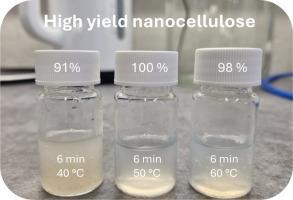超分子化学驱动脱木质素软木制备高产量纳米纤维素
IF 12.5
1区 化学
Q1 CHEMISTRY, APPLIED
引用次数: 0
摘要
以百里酚和甲磺酸为溶剂,对超分子化学驱动的脱木质素软木进行超声处理,制备纳米纤维素(NC)。超分子化学驱动的脱木质素作用可以在非常温和的条件下(40°C - 60°C, 1-5分钟)进行,从而可以以非常低的能耗生产低木质素含量的纤维素纸浆(CP)。由于条件温和,获得了光学性能好(白度高)的CP。在最好的情况下,CP可以在超声过程中完全分解成纳米级的成分。对于原始木材的质量,最多有一半的质量可以转化为NC,显示出良好的材料有效性,特别是在考虑极其温和的脱木质素条件时。基于形态学分析,NC由元素原纤维组成,其长度从短的纤维素纳米晶体状颗粒到细长的纤维素纳米纤维型原纤维不等。由于这些形态特性,与商业纤维素纳米晶体相比,NC悬浮液具有高透明度和相对较高的粘度。此外,NC对聚乙烯醇薄膜具有良好的增强作用。因此,超分子化学驱动的脱木质素作用是一种极具潜力的绿色处理方法,可以生产低木质素含量的CP,并易于转化为优质的生物基纳米材料。本文章由计算机程序翻译,如有差异,请以英文原文为准。

High-yield nanocellulose from supramolecular chemistry-driven delignified softwood
In this study, nanocellulose (NC) was produced via ultrasonication of supramolecular chemistry-driven delignified softwood with thymol and methanesulfonic acid-based solvent. Supramolecular chemistry-driven delignification could be performed under very mild conditions (40 °C–60 °C for 1–5 min), allowing the production of cellulosic pulp (CP) with low lignin content to take place with very low energy consumption. Due to the mild conditions, CP with good optical properties (high whiteness) was obtained. In the best cases, CP could be completely disintegrated into its nanosized constituents during ultrasonication. Regarding the mass of original wood, at maximum, half of the mass could be converted into NC, demonstrating good material effectiveness, particularly when considering extremely mild delignification conditions. Based on morphology analysis, NC consisted of elemental fibrils with lengths ranging from short, cellulose nanocrystal-like particles to elongated, cellulose nanofiber-type fibrils. Owing to these morphological properties, NC suspensions exhibited high transparency and relatively high viscosity compared with commercial cellulose nanocrystals. Furthermore, NC exerted excellent reinforcement effect on polyvinyl alcohol films. Therefore, supramolecular chemistry-driven delignification is a highly potential green treatment method for producing CP with low lignin content to be easily converted to as quality bio-based nanomaterial.
求助全文
通过发布文献求助,成功后即可免费获取论文全文。
去求助
来源期刊

Carbohydrate Polymers
化学-高分子科学
CiteScore
22.40
自引率
8.00%
发文量
1286
审稿时长
47 days
期刊介绍:
Carbohydrate Polymers stands as a prominent journal in the glycoscience field, dedicated to exploring and harnessing the potential of polysaccharides with applications spanning bioenergy, bioplastics, biomaterials, biorefining, chemistry, drug delivery, food, health, nanotechnology, packaging, paper, pharmaceuticals, medicine, oil recovery, textiles, tissue engineering, wood, and various aspects of glycoscience.
The journal emphasizes the central role of well-characterized carbohydrate polymers, highlighting their significance as the primary focus rather than a peripheral topic. Each paper must prominently feature at least one named carbohydrate polymer, evident in both citation and title, with a commitment to innovative research that advances scientific knowledge.
 求助内容:
求助内容: 应助结果提醒方式:
应助结果提醒方式:


